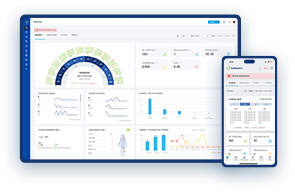
How Technology Is Shaping The Future Of Occupational Health and Safety
Ensuring workplace safety is a critical responsibility for organizations, both to comply with legal requirements and to protect their employees. Despite stringent safety protocols, over 2.3 million people worldwide succumb to work-related accidents each year.
Historically, safety measures were often reactive, implemented only after accidents occurred. The field of Environmental, Health, and Safety (EHS) emerged in response to catastrophic incidents like the Seveso Disaster in 1976 and the Bhopal Disaster in 1984.
But can we control and measure accidents caused by unintentional acts or unforeseen events?
With modern technology, we can significantly improve our ability to prevent accidents before they happen. Advanced EHS software leverages data to identify potential risks and implement preventative measures, moving from reactive to proactive safety management.
Leveraging Technology for Occupational Health and Safety
1. Behavioral Analysis to Prevent Accidents:
Human error is a major cause of workplace accidents, often resulting from negligence, overconfidence, or a lack of attention to detail. Smart safety systems continuously capture and analyze data, helping to identify risky behaviors and enforce compliance with safety protocols. This data-driven approach enables organizations to address the root causes of unsafe behavior and implement targeted interventions.
2. Real-Time Monitoring and Alerts:

Accidents can occur at any time and place, but technology can help monitor employee activities in real-time. Tools like incident management systems and audit management systems allow employees to report incidents or conduct audits via mobile devices, instantly updating a central database. This ensures that critical information reaches the right people promptly, facilitating timely corrective actions.
3. Smart Wearables and Field-Force Management:
Wearable technology, such as smart helmets and smartwatches, can provide real-time insights into on-site activities. These devices, often equipped with augmented reality capabilities, enhance situational awareness and improve communication between field workers and safety leaders. Additionally, digitized permit-to-work systems with geo-mapping capabilities offer a comprehensive view of employee activities, enabling quick decisions to enhance safety.
4. Engaging Employees with Intuitive Technology:
Modern employees have shorter attention spans, making it crucial to deliver safety information through preferred digital channels like emails, chats, and notifications. A well-designed, user-friendly interface can further improve engagement by providing an easy-to-navigate and intuitive experience. Organizations should leverage technology that resonates with current user behaviors to effectively communicate safety protocols and alerts.
5. Enhanced Data Analytics for Informed Decisions:
Data analytics play a pivotal role in occupational health and safety. Advanced EHS software collects vast amounts of data from various sources, allowing organizations to analyze trends and patterns. This information helps in making informed decisions, predicting potential hazards, and improving overall safety strategies. Predictive analytics can identify areas of concern before they become critical, enabling proactive measures to be taken.
6. Integration with IoT and AI:

The integration of the Internet of Things (IoT) and Artificial Intelligence (AI) in safety management systems has revolutionized the way organizations monitor and manage workplace safety. IoT devices can continuously monitor environmental conditions, equipment status, and employee health metrics, sending real-time data to a centralized system. AI algorithms can analyze this data to predict potential risks and recommend preventive actions, enhancing overall safety management.
7. Virtual Reality for Training and Simulations:
Virtual Reality (VR) technology offers immersive training experiences, allowing employees to practice safety protocols in a controlled environment. VR simulations can recreate hazardous scenarios, enabling workers to learn how to respond effectively without the risk of real-world consequences. This hands-on approach to training enhances knowledge retention and ensures that employees are better prepared for emergencies.
8. Automated Compliance Management:
Staying compliant with occupational health and safety regulations can be challenging, but technology can simplify the process. Automated compliance management systems ensure that all safety protocols and regulations are consistently followed. These systems can track regulatory changes, update safety procedures accordingly, and maintain detailed records for audits and inspections. This reduces the risk of non-compliance and potential legal issues.
9. Remote Safety Management:
The rise of remote work has introduced new challenges for occupational health and safety. However, technology provides solutions to manage safety remotely. Cloud-based EHS software enables safety managers to monitor incidents, conduct audits, and track compliance from any location. Remote monitoring tools ensure that even off-site employees adhere to safety protocols, maintaining a safe work environment regardless of physical location.
Conclusion
A safe workplace is a productive workplace. By adopting advanced technological solutions, organizations can foster a safety culture that prioritizes the well-being of their employees. Implementing cutting-edge EHS software can help foresee potential incidents, ensure compliance, and promote operational excellence and sustainability. As technology continues to evolve, it holds the promise of creating safer work environments and driving continuous improvement in occupational health and safety. With the evolving stature of technology advancement, we might finally be able to foresee incidents, build devices that protect us like never before, go beyond compliance, and create a workspace that brings operational excellence and sustainability by putting the well-being of workers at its core value.
Ben Johnson is a dedicated Customer Success Executive at Safetymint. With a strong commitment to excellence, Ben works closely with customers to ensure they fully leverage the capabilities of Safetymint to its fullest potential, aiming to significantly reduce or mitigate safety risks and incidents.




